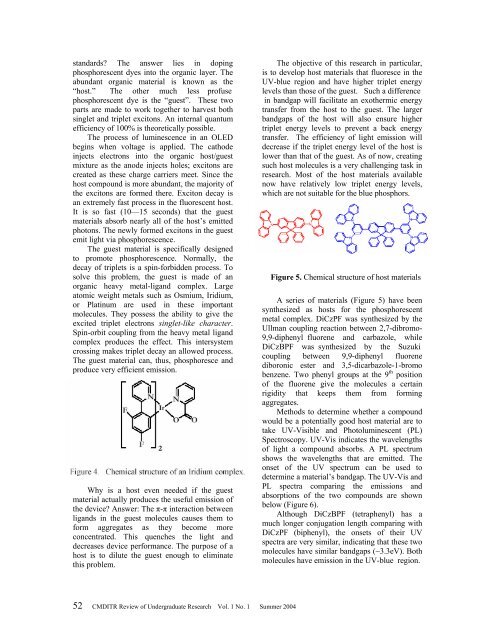CMDITR Review of Undergraduate Research - Pluto - University of ...
CMDITR Review of Undergraduate Research - Pluto - University of ...
CMDITR Review of Undergraduate Research - Pluto - University of ...
Create successful ePaper yourself
Turn your PDF publications into a flip-book with our unique Google optimized e-Paper software.
standards? The answer lies in doping<br />
phosphorescent dyes into the organic layer. The<br />
abundant organic material is known as the<br />
“host.” The other much less pr<strong>of</strong>use<br />
phosphorescent dye is the “guest”. These two<br />
parts are made to work together to harvest both<br />
singlet and triplet excitons. An internal quantum<br />
efficiency <strong>of</strong> 100% is theoretically possible.<br />
The process <strong>of</strong> luminescence in an OLED<br />
begins when voltage is applied. The cathode<br />
injects electrons into the organic host/guest<br />
mixture as the anode injects holes; excitons are<br />
created as these charge carriers meet. Since the<br />
host compound is more abundant, the majority <strong>of</strong><br />
the excitons are formed there. Exciton decay is<br />
an extremely fast process in the fluorescent host.<br />
It is so fast (10—15 seconds) that the guest<br />
materials absorb nearly all <strong>of</strong> the host’s emitted<br />
photons. The newly formed excitons in the guest<br />
emit light via phosphorescence.<br />
The guest material is specifically designed<br />
to promote phosphorescence. Normally, the<br />
decay <strong>of</strong> triplets is a spin-forbidden process. To<br />
solve this problem, the guest is made <strong>of</strong> an<br />
organic heavy metal-ligand complex. Large<br />
atomic weight metals such as Osmium, Iridium,<br />
or Platinum are used in these important<br />
molecules. They possess the ability to give the<br />
excited triplet electrons singlet-like character.<br />
Spin-orbit coupling from the heavy metal ligand<br />
complex produces the effect. This intersystem<br />
crossing makes triplet decay an allowed process.<br />
The guest material can, thus, phosphoresce and<br />
produce very efficient emission.<br />
Why is a host even needed if the guest<br />
material actually produces the useful emission <strong>of</strong><br />
the device? Answer: The π-π interaction between<br />
ligands in the guest molecules causes them to<br />
form aggregates as they become more<br />
concentrated. This quenches the light and<br />
decreases device performance. The purpose <strong>of</strong> a<br />
host is to dilute the guest enough to eliminate<br />
this problem.<br />
The objective <strong>of</strong> this research in particular,<br />
is to develop host materials that fluoresce in the<br />
UV-blue region and have higher triplet energy<br />
levels than those <strong>of</strong> the guest. Such a difference<br />
in bandgap will facilitate an exothermic energy<br />
transfer from the host to the guest. The larger<br />
bandgaps <strong>of</strong> the host will also ensure higher<br />
triplet energy levels to prevent a back energy<br />
transfer. The efficiency <strong>of</strong> light emission will<br />
decrease if the triplet energy level <strong>of</strong> the host is<br />
lower than that <strong>of</strong> the guest. As <strong>of</strong> now, creating<br />
such host molecules is a very challenging task in<br />
research. Most <strong>of</strong> the host materials available<br />
now have relatively low triplet energy levels,<br />
which are not suitable for the blue phosphors.<br />
Figure 5. Chemical structure <strong>of</strong> host materials<br />
A series <strong>of</strong> materials (Figure 5) have been<br />
synthesized as hosts for the phosphorescent<br />
metal complex. DiCzPF was synthesized by the<br />
Ullman coupling reaction between 2,7-dibromo-<br />
9,9-diphenyl fluorene and carbazole, while<br />
DiCzBPF was synthesized by the Suzuki<br />
coupling between 9,9-diphenyl fluorene<br />
diboronic ester and 3,5-dicarbazole-1-bromo<br />
benzene. Two phenyl groups at the 9 th position<br />
<strong>of</strong> the fluorene give the molecules a certain<br />
rigidity that keeps them from forming<br />
aggregates.<br />
Methods to determine whether a compound<br />
would be a potentially good host material are to<br />
take UV-Visible and Photoluminescent (PL)<br />
Spectroscopy. UV-Vis indicates the wavelengths<br />
<strong>of</strong> light a compound absorbs. A PL spectrum<br />
shows the wavelengths that are emitted. The<br />
onset <strong>of</strong> the UV spectrum can be used to<br />
determine a material’s bandgap. The UV-Vis and<br />
PL spectra comparing the emissions and<br />
absorptions <strong>of</strong> the two compounds are shown<br />
below (Figure 6).<br />
Although DiCzBPF (tetraphenyl) has a<br />
much longer conjugation length comparing with<br />
DiCzPF (biphenyl), the onsets <strong>of</strong> their UV<br />
spectra are very similar, indicating that these two<br />
molecules have similar bandgaps (~3.3eV). Both<br />
molecules have emission in the UV-blue region.<br />
52 <strong>CMDITR</strong> <strong>Review</strong> <strong>of</strong> <strong>Undergraduate</strong> <strong>Research</strong> Vol. 1 No. 1 Summer 2004




